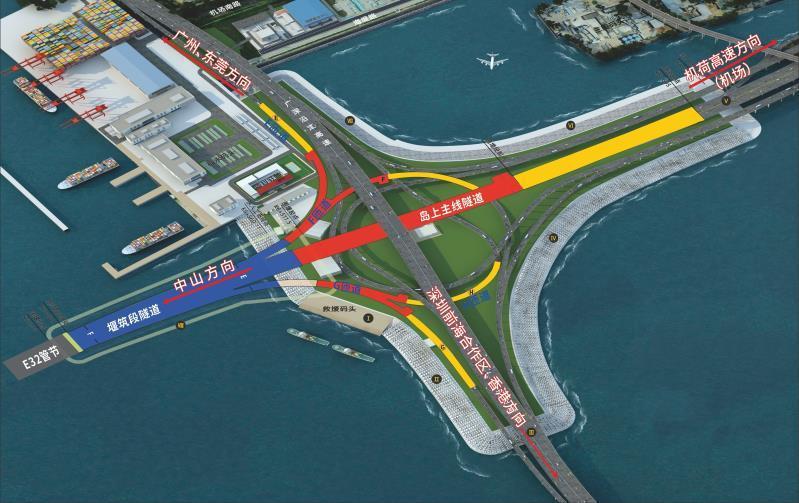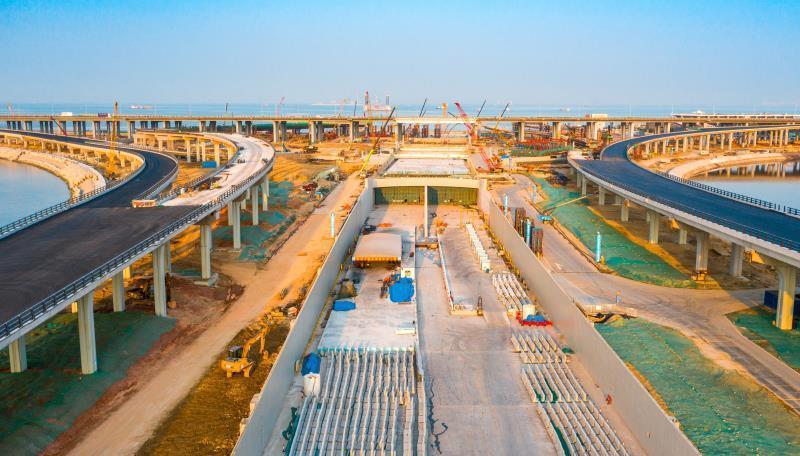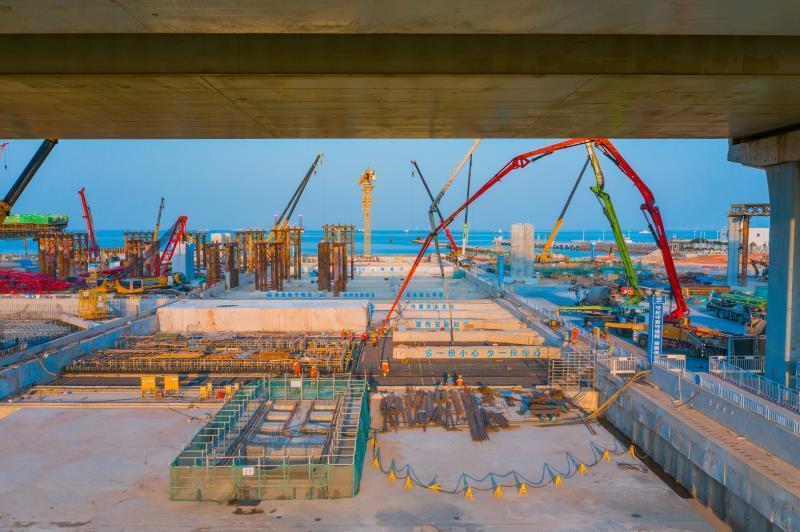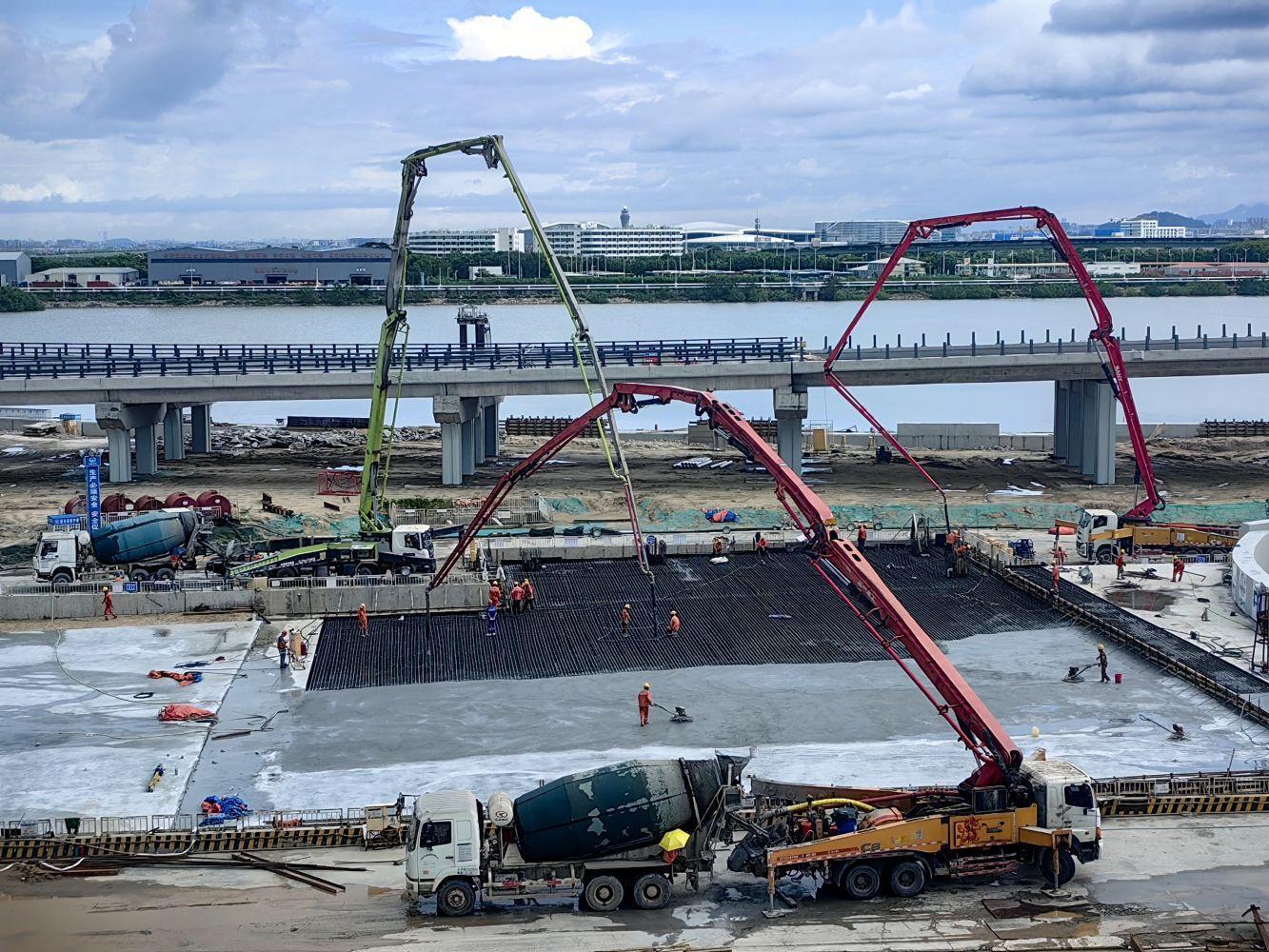
On June 20th at 14:00, with the pouring of the final section of the main tunnel's concrete roof, the main structure of the eastern artificial island in the major national project, the Shenzhen-Zhongshan Link, has been completed. This milestone also signifies the formal formation of the first underwater interchange hub for a high-speed highway in China.

The Shenzhen-Zhongshan Link, an integral cross-sea project including bridges, islands, tunnels and underwater interchange engineering, is the crucial part of the vital "A-shaped" transportation framework of the Guangdong-Hong Kong-Macao Greater Bay Area. The eastern artificial island serves as the gateway to the Shenzhen side of the link, located south of the Shenzhen Bao'an International Airport and adjacent to the Shenzhen Airport Fuyong Ferry Terminal. It connects to the ongoing construction of the Guangzhou-Shenzhen section of the Guangzhou-Shenzhen Riverside Expressway and links to the project's underwater tunnel on the west.

With a land area of 343,800 square meters, equivalent to 48 standard soccer fields, the eastern artificial island features tunnels, a rescue pier, power supply and distribution buildings, and related supporting facilities. The tunnels include a 480-meter embankment tunnel, an 855-meter main tunnel on the island, and four ramp tunnels for traffic transition.
The construction of the eastern artificial island faced significant challenges, including a large-scale project volume, multiple concurrent operations, various types of foundation pit support structures, and high environmental protection requirements. Furthermore, the construction had to proceed without disrupting the operation of existing projects such as the Shenzhen Bao'an International Airport and the Guangzhou-Shenzhen Riverside Expressway.

To address the issue of short-term stress concentration caused by the concentrated sea sand around bridge piers, the construction team innovatively adopted the "sand-filled bags" method for sand filling operations. This involved placing sea sand into specially designed bags, creating layers of "sand blankets", which were then uniformly spread around the bridge piers. This approach effectively resolved the issue of uneven load distribution.
The construction of the eastern artificial island commenced on December 21, 2017. After more than 2,000 challenging days, the construction team overcame difficulties in preventing seepage and controlling uniform backfilling during the construction of deep and wide foundation pits in the deep-sea soft soils. They also tackled the formidable problem of minimizing deformation in nearby structures caused by deep foundation pit construction. This T-shaped artificial island has taken a significant step towards its goal of opening to traffic by 2024.
Currently, the construction of the Shenzhen-Zhongshan Link is entering its final stage. In the future, the eastern artificial island will facilitate travel to Huizhou and Shenzhen's Longgang District on the east, Zhongshan and Zhuhai on the west, Guangzhou and Dongguan on the north, and the Shenzhen Qianhai Cooperation Zone and Hong Kong on the south, contributing to the formation of a one-hour living circle between major cities in the Greater Bay Area.
深中通道东人工岛主体结构完工!
6月20日14时,随着主线隧道最后一段顶板混凝土完成浇筑,国家重大工程深中通道的东人工岛主体结构施工全面完成,同时也标志着国内首个高速公路水下互通立交主体正式成形。
深中通道是世界级“桥、岛、隧、水下互通”跨海集群工程,粤港澳大湾区“A”字型交通主骨架最关键一横。东人工岛是该项目深圳端门户工程,位于深圳宝安机场国际南侧,紧邻福永机场码头,东连在建广深沿江高速深圳段侧接线工程,西接项目海底隧道。
东人工岛全岛陆域面积34.38万平方米,相当于48个国际标准足球场,岛上设隧道工程、救援码头、供配电配套用房及相关附属配套设施,其中,隧道工程包括长480米的堰筑段隧道、长855米的岛上主线隧道,以及实现交通转换的4条匝道隧道。
东人工岛施工面临着工程规模体量大、交叉作业多、基坑支护结构型式多、环保要求高等突出难点,且在建设过程中不能影响深圳宝安国际机场、广深沿江高速等既有项目的运营。
为了解决采用船舶在桥墩周边吹填海砂时,只能集中吹填到一处,无法实时分散而产生的短时应力集中问题,建设团队创新性采用了“砂被”方法进行填砂作业,也就是将海砂装在一个个特制的袋子里,做成一床床的“砂被”,然后一层一层均匀地摊铺在桥墩四周,有效解决了偏载问题。
2017年12月21日东人工岛正式开工建设,经过2000多天攻坚克难,建设团队相继攻克了海域深厚软基超深超宽基坑集群工程施工阶段防渗止水及回填均匀控制难题,破解了深基坑施工抵近构造物小变形世界难题,这座“一体两翼”的“T形”人工岛向2024年通车目标迈进了关键的一大步。
目前,深中通道土建工程收官战进入最后阶段。未来经深中通道东人工岛,可东往惠州、深圳龙岗区,西往中山、珠海,北往广州、东莞,南往深圳前海合作区、香港方向,推动大湾区主要城市间一小时生活圈的形成。
文|羊城晚报全媒体记者 王丹阳
通讯员 粤交集宣 岳路建 沈仲 申林冬
图|通讯员 李一 赵永才
翻译|刘佳慧
责编|王瑜瑛









